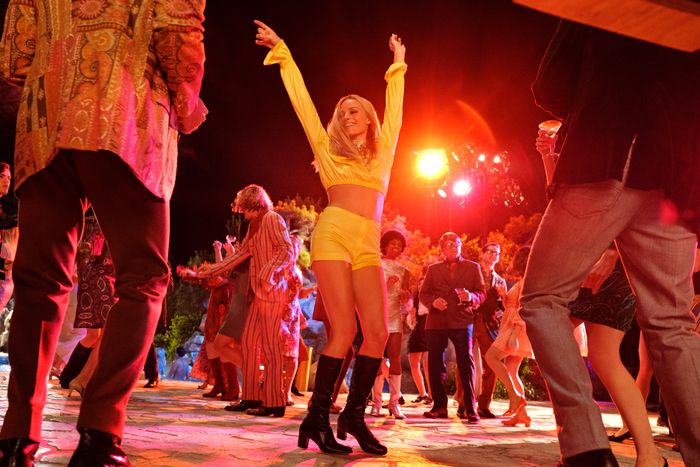
Quentin Tarantino isn’t the only director who makes movies that address, invoke, extol, parody, imitate, and fetishize other movies, but he’s one of the few whose dialogues with the past can occupy the same artistic plane as the objects of his reverence — and can even, on happier occasions, transcend it. Once Upon a Time in Hollywood is a very happy occasion. It’s a ramshackle ’60s pastiche that acquires a life of its own, evoking not just an era and its pop culture but also celebrating the impulse to recreate and (the effrontery!) rewrite the past in line with his fantasies. Say what you will about those fantasies — they’re innocent, they’re deviant, they’re sometimes weirdly both at once — but no one imparts his pipe dreams so seductively.
The ’60s that engages Tarantino doesn’t touch on the healthy and corrective elements of the counterculture. If anything, he’s a reactionary, nostalgic for the lone-gunman TV Westerns of the ’50s and early ’60s, while using the Manson “family” members to represent hippies. Leonardo DiCaprio plays Rick Dalton, a fading Western TV star with a star-size drinking problem. Rick would self-destruct in private but for his bud, his amigo, his stuntman/driver/gofer/one-man entourage, Cliff Booth, played by Brad Pitt. Discomfort is built into the relationship, because Cliff can’t get work on his own (there’s a scandal in his past) and because Rick no longer has the clout to ensure that Cliff will be hired along with him. It gets awkward. Tagging along, Cliff seems like a bit of a masochist: After chauffeuring Rick home, he returns to his trailer, watches Mannix, and eats a bowl of macaroni and cheese (from a box) while his big dog beside him has a bowl of dog food (from a can — and slimy). They’re both good dogs. Rick, meanwhile, must consider a life in Italy with or without Cliff, where spaghetti Westerns beckon to American actors past their prime.
For a while, Once Upon a Time seems as if it’s going to be nothing but a series of extended digressions. But it’s shaped like a Western, and gets better, tighter, and more surprising as it moseys along, plainly building to the grisly, still-inexplicable tragedy that’s said to have ended the hedonistic feel of late-’60s Hollywood. Next door to Rick on Cielo Drive in the Hollywood Hills live Roman Polanski — super-hot off Rosemary’s Baby — and his young bride, Sharon Tate (Margot Robbie), whom we know going in will be butchered on the night of August 9, 1969, by Manson family members at the behest of their psychotic overlord. Tate is the film’s third and lesser protagonist, but Robbie has one of its most moving scenes, in which Tate goes to a theater to watch herself in a new Dean Martin–Matt Helm movie. If Tarantino has a Dream Girl, it would be Robbie here, her dirt-smudged bare feet (he’s notorious for his foot fetishism) on the chair in front of her, wide-eyed at seeing herself best Nancy Kwan in a karate fight. Be still my heart! That the footage onscreen is of the real Sharon Tate makes the sequence even more poignant.
I’m slightly older than Tarantino (I was born in ’59, Tarantino in ’63) but we share a nostalgia for a culture we saw only from afar, too young to have gotten in on all the R-rated fun. As shot in glowing hues by Robert Richardson and designed by Barbara Ling (production) and Arianne Phillips (costumes), the bric-a-brac constitutes its own kind of fetishism. Marquees with titles like Three in an Attic (what did the trio do up there?) are tantalizing, and so are radio commercials for perfume and trailers for such movies as C.C. and Company with Joe Namath on a motorcycle (plus Ann-Margret). There was no home video, of course, and no streaming, so you saw movies in theaters or waited for them to show up (edited, panned-and-scanned, broken up by commercials) on TV (on one of only six or seven channels). There’s no reason for Tarantino to have Rick’s effusive new agent (Al Pacino) mention that he watched Rick’s movies at home in 35 millimeter and TV shows in 16 except that it sounds so exotic, like saying you listened to a single at 45 rpm. An issue of TV Guide (how umbilically attached we were to it!) sits on Cliff’s table. Robert Goulet murders “MacArthur Park” on the TV screen. Tarantino sets off the Mannix opening with its floating split screens and brassy Lalo Schifrin theme the way Warhol set off his soup cans. The jam-packed soundtrack, chockablock with goodies, is its own love letter to the ’60s. Tarantino gives you the sense that he makes movies to be able to live inside them. They’re his time machines.
His dialogue doesn’t have the tension of his other movies, but after the interminable macho patter of The Hateful Eight, I welcomed the gentle pacing and the characters’ introspection. I’ve never enjoyed DiCaprio more than in the middle section, in which Rick is a guest villain on a pilot for another TV Western starring an actor played by Timothy Olyphant. He has an exchange on a porch with little Julia Butters (a star is born!) as an endearingly serious child actress that proves DiCaprio doesn’t have to grandstand to draw you into his character’s alienation. He doesn’t even have to furrow that wide brow to suggest deep thoughts — they’re there in his stillness and in his melancholy, near-musical drawl. There’s a scene in his trailer (“You’re a fuckin’ miserable drunk!” he screams at himself in the mirror. “Get the lines right or I’ll blow your fuckin’ brains out!”) that taps into an aspect of DiCaprio’s personality I’ve never seen onscreen before — the fear of screwing up to a point where he won’t be noticed anymore. (Nicholas Hammond is wonderful as the show’s director, Sam Wanamaker, an actor who’d go on to recreate Shakespeare’s Globe Theatre in London; Tarantino introduces just enough Shakespearean diction into Wanamaker’s lines to capture the essence of his passion.)
Cliff’s big sequence is almost as amazing. Tarantino has never written something as quietly foreboding as Cliff’s visit to the Spahn Ranch, a former set for Westerns in which the Manson family has taken up residence. Cliff has given a lift to one of the “girls,” played by Margaret Qualley (best known for The Leftovers), who beckons to him with her eyes and then her whole body — so light it’s as if she’s wafted on air currents. (This is another star-making turn.) Cliff trudges around the compound under the suspicious glare of other girls — a posse that includes Lena Dunham and Dakota Fanning as “Squeaky” Fromme — in search of the owner he worked with a decade earlier. In Mary Harron’s recent Manson drama, Charlie Says, the blind, elderly Spahn was seen being fellated by a Manson girl, but here he’s a full-blown figure of pathos played by Bruce Dern, whose customary cantankerousness suggests a man whose age and disabilities have helped transform him into a helpless addict. (Manson doesn’t appear in this sequence. Damon Herriman plays him with spooky dishevelment in a scene in which the madman wanders onto Tate’s property looking for its previous resident, the music producer Terry Melcher.)
It’s hard to do justice to the riches of Once Upon a Time in Hollywood, to its cameos (Damian Lewis as mean Steve McQueen!) and its droll bits of business, among them a devilish shot featuring a speargun. Tarantino has audaciously written Bruce Lee (played by Mike Moh) as an arrogant dick who lectures Hollywood stuntmen on his superiority. There are lapses. Al Pacino doesn’t have the fine-tuning for a Tarantino movie — his generalized hamminess sticks out. The shots of the lank-haired, scowling Manson girls spread out in a line are a misogynist’s nightmare — they look ready to tear Cliff to pieces like the Dionysian harpies in The Bacchae. I’m troubled that Tarantino suggests (even satirically) that square-jawed macho cowboys were victims of the counterculture and would have been (along with their fists, guns, and flamethrowers) the answer to its excesses.
But on its own terms, Once Upon a Time in Hollywood is a farrago of genius. Because of the horror that’s imminent, a sequence in which Hollywood’s neon signs (El Coyote, Musso & Frank, and more) hum to life as the sky darkens on August 9 is both lyrical and bristling with dread. The convulsively brutal climax I wouldn’t dare to spoil. The finale is a wonder. Has there ever been a scene so simultaneously euphoric and heartbreaking? Tarantino’s dream world is a sadistic place, but in a way it’s sublime, like heaven nestled inside hell.







